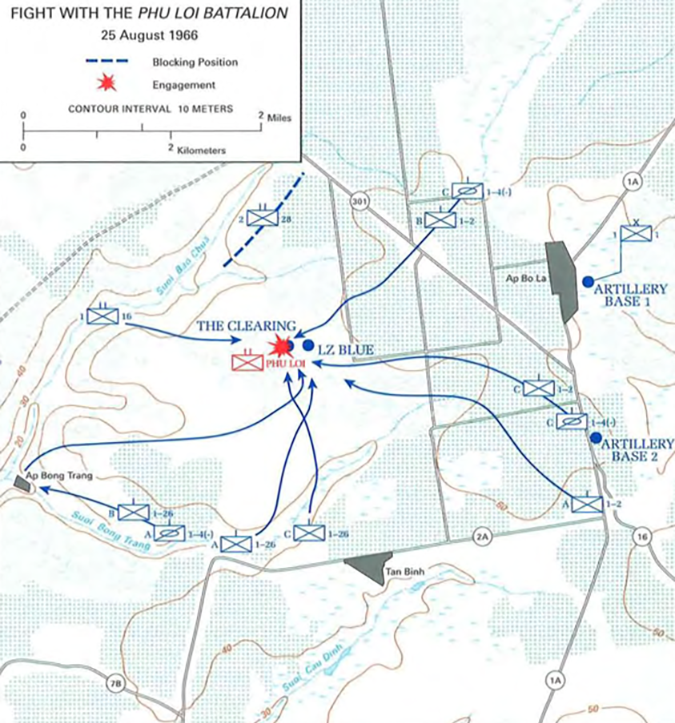Week of August 27
On August 23, 1966, the U.S. Army 1st Infantry Division launched Operation AMARILLO, a search-and-destroy and road security operation in III Corps, covering parts of Biên Hòa and Bình Dương Provinces. The 1st Division had been in Vietnam for ten months and were part of the United States' campaign to stem the tide of Communist successes in South Vietnam with a rapid buildup of U.S. military forces. Operation AMARILLO took place in heavily forested jungle terrain. The area was thick with tall trees, tangled vines, heavy underbrush, and a network of Việt Cộng trails and camps. To add to the 1st Division's challenges, August was the peak of the monsoon season.
The operation began uneventfully. But in the early morning hours of August 25, a 15-man patrol stumbled unexpectedly into a major Việt Cộng base area - a base, it would turn out, belonging to the Việt Cộng elite "Phu Loi" Battalion.
The infantrymen radioed for reinforcements after coming under heavy small arms and automatic weapons fire. But as a relief column made its way toward the trapped men, Việt Cộng troops ambushed the column in a small clearing. A second, larger close quarters firefight began.
U.S. commanders quickly organized another relief operation, and several more infantry and cavalry units converged on the site of the fight. The clearing where the ambush occurred was so small that there was room for only a single helicopter, and the dense jungle and general confusion made it difficult for the surrounded men to coordinate a cohesive defense. One medevac chopper was shot down early on, obstructing the small landing area and making the evacuation of casualties nearly impossible. U.S. reinforcements eventually secured another landing zone several hundred yards away, LZ Blue, from which to evacuate the wounded.
The battle continued for most of the day. The Phu Loi Battalion's base was a well-fortified network of bunkers, tunnels, and trenches, while the Americans were forced to make do with whatever cover they could find. Communist troops also had heavy weapons-including large caliber machine guns, recoilless rifles, and grenade launchers-and an intimate knowledge of the terrain, giving them yet another advantage.
U.S. troops took heavy casualties but finally managed to establish a coherent perimeter before nightfall. Early the next morning, U.S. commanders called in air strikes. Two napalm canisters came in off target, killing two Americans and wounding over a dozen others. In the early morning of the next day, reconnaissance patrols found that the Việt Cộng had withdrawn in the night. The rest of Operation AMARILLO was uneventful as the Việt Cộng troops in the area declined to reengage. The operation ended on September 1, 1966. A total of 41 Americans were killed during AMARILLO, 34 of them on August 25. Almost 250 were wounded. Of the 15 men in the original patrol that stumbled into the base, six were killed in action. Việt Cộng casualties were much higher. Between 102 and 171 Việt Cộng soldiers were killed and many more were wounded, reducing the crack Phu Loi Battalion to about half strength.
The battle on August 25, 1966, illustrated the challenges that U.S. troops faced for most of the war: ground that was well known to enemy forces but not to allied troops; a hot, humid, and rainy climate that exhausted men and equipment; terrain that impeded maneuverability and visibility; and enemy troops who were tough to find and to pursue. Despite these challenges, American troops nearly always prevailed in combat, never losing a major battle during the war.1
1David Burns Sigler, Vietnam Battle Chronology: U.S. Army and Marine Corps Combat Operations, 1965-1973 (Jefferson, N.C.: McFarland & Company, Inc., 1992), 24; John M. Carland, United States Army in Vietnam, Combat Operations: Stemming the Tide, May 1965 to October 1966 (Washington, DC: Center of Military History, 2000), 325-33.
|

|
Map illustrating the 1st Infantry Division's fight with the Viet Cong "Phu Loi" Battalion, August 25, 1966. (Center of Military History)